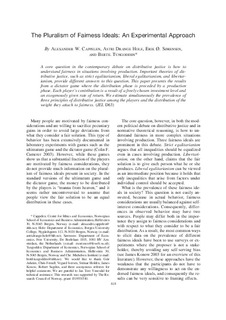| dc.contributor.author | Cappelen, Alexander W. | |
| dc.contributor.author | Hole, Astri Drange | |
| dc.contributor.author | Sørensen, Erik Ø. | |
| dc.contributor.author | Tungodden, Bertil | |
| dc.date.accessioned | 2016-10-10T10:45:18Z | |
| dc.date.accessioned | 2016-10-12T10:25:56Z | |
| dc.date.available | 2016-10-10T10:45:18Z | |
| dc.date.available | 2016-10-12T10:25:56Z | |
| dc.date.issued | 2007 | |
| dc.identifier.citation | Cappelen, Alexander W., Astri Drange Hole, Erik Ø Sørensen and Bertil Tungodden. 2007. "The Pluralism of Fairness Ideals: An Experimental Approach." American Economic Review, 97(3): 818-827. | nb_NO |
| dc.identifier.issn | 0002-8282 | |
| dc.identifier.uri | http://hdl.handle.net/11250/2414512 | |
| dc.description | ---Copyright © 1998, 1999, 2000, 2001, 2002, 2003, 2004, 2005, 2006, 2007, 2008, 2009, 2010, 2011, 2012, 2013, 2014, 2015, 2016 by the American Economic Association. Permission to make digital or hard copies of part or all of American Economic Association publications for personal or classroom use is granted without fee provided that copies are not distributed for profit or direct commercial advantage and that copies show this notice on the first page or initial screen of a display along with the full citation, including the name of the author. Copyrights for components of this work owned by others than AEA must be honored. Abstracting with credit is permitted. The author has the right to republish, post on servers, redistribute to lists and use any component of this work in other works. For others to do so requires prior specific permission and/or a fee. Permissions may be requested from the American Economic Association Administrative Office by going to the Contact Us form and choosing "Copyright/Permissions Request" from the menu. Copyright © 2016 AEA | nb_NO |
| dc.description.abstract | A core question in the contemporary debate on distributive justice is how to understand fairness in situations involving production. Important theories of distributive justice, such as strict egalitarianism, liberal egalitarianism, and libertarianism, provide different answers to this question. This paper presents the results from a dictator game where the distribution phase is preceded by a production phase. Each player's contribution is a result of a freely chosen investment level and an exogenously given rate of return. We estimate simultaneously the prevalence of three principles of distributive justice among the players and the distribution of the weight they attach to fairness. | nb_NO |
| dc.language.iso | eng | nb_NO |
| dc.publisher | American Economic Association | nb_NO |
| dc.title | The pluralism of fairness ideals: An experimental approach | nb_NO |
| dc.title.alternative | The pluralism of fairness ideals: An experimental approach | |
| dc.type | Journal article | nb_NO |
| dc.type | Peer reviewed | nb_NO |
| dc.date.updated | 2016-10-10T10:45:18Z | |
| dc.rights.holder | Copyright © 2016 AEA | nb_NO |
| dc.source.pagenumber | 818-827 | nb_NO |
| dc.source.volume | 97 | nb_NO |
| dc.source.journal | American Economic Review | nb_NO |
| dc.source.issue | 3 | nb_NO |
| dc.identifier.doi | 10.1257/aer.97.3.818 | |
| dc.identifier.cristin | 624329 | |
